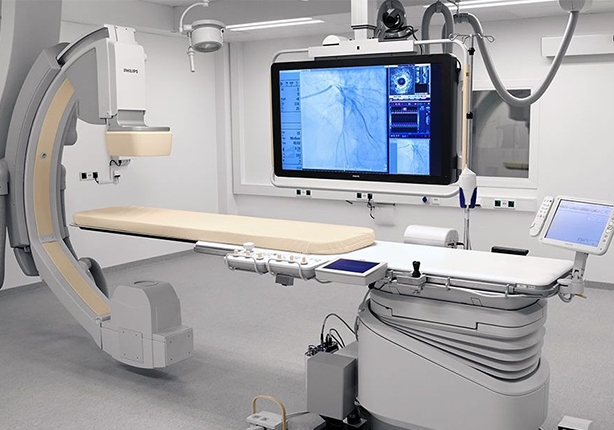

Cardiac catheterisation is an invasive diagnostic procedure that provides important information about the structure and function of the heart. It usually involves taking X-ray pictures of the heart’s arteries (coronary arteries) using a technique called coronary angiography or arteriography. The resulting images are known as coronary angiograms or arteriogram.
Angiography is used to detect abnormalities or blockages in the blood vessels (called occlusions) throughout the circulatory system and in some organs. The procedure is commonly used to identify atherosclerosis; to diagnose heart disease; to evaluate kidney function and detect kidney cysts or tumors; to detect an aneurysm (an abnormal bulge of an artery that can rupture leading to hemorrhage), tumor, blood clot, or arteriovenous malformations (abnormal tangles of arteries and veins) in the brain; and to diagnose problems with the retina of the eye. It is also used to give surgeons an accurate “map” of the heart prior to open-heart surgery, or of the brain prior to neurosurgery. Angiography is usually performed at a hospital by a trained cardiologist and assisting technician or nurse. It takes place in the patient’s vital signs will be monitored throughout the procedure. Angiography requires the injection of a contrast dye that makes the blood vessels visible to x ray. The dye is injected through a procedure known as arterial puncture. The puncture is usually made in the groin area, armpit, inside elbow, or neck. The site is cleaned with an antiseptic agent and injected with a local anesthetic. First, a small incision is made in the skin to help the needle pass. A needle containing an inner wire called a stylet is inserted through the skin into the artery. When the cardiologist has punctured the artery with the needle, the stylet is removed and replaced with another long wire called a guide wire. It is normal for blood to spout out of the needle before the guide wire is inserted.
The term angioplasty means using a balloon to stretch open a narrowed or blocked artery. However, most modern angioplasty procedures also involve inserting a short wire-mesh tube, called a stent, into the artery during the procedure. The stent is left in place permanently to allow blood to flow more freely. Coronary angioplasty is sometimes known as Percutaneous Transluminal Coronary Angioplasty (PTCA). The combination of coronary angioplasty with stenting is usually referred to as Percutaneous Coronary Intervention (PCI). The blood flow through the coronary arteries improves after an angioplasty. Many people find that any symptoms they had get significantly better and they’re able to do more than they could before the procedure. If you’ve had a heart attack, an angioplasty can increase your chances of surviving more than clot-busting medication (thrombolysis) can and the procedure can also reduce your chances of having another heart attack in the future.